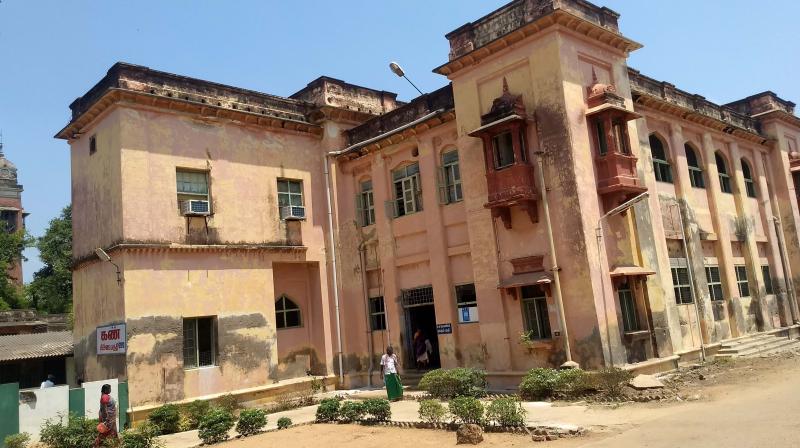Royals, landlords behind RMH ophthalmology department
Almost 30 to 40 in-patients can be seen almost any time, which currently peaks to even 60 patients.

THANJAVUR: The Ophthalmology department of the Thanjavur Medical College, functioning from Rajah Mirasudhar Government Hospital (RMH) in the heart of the town, which is celebrating its centenary this year, has an interesting history connected to royal families and landlords of yore.
Tracing the history of the department, the institution dates back to 1919. All through the years, it has been catering to the needs of a minimum of 400 out-patients from various neighbouring districts like Thanjavur, Tiruvarur, Nagapattinam, Tiruchy, Pudukottai, Perambalur, Ariyalur, Cuddalore, Karur and their suburbs. Almost 30 to 40 in-patients can be seen almost any time, which currently peaks to even 60 patients.
A stone plaque in the hospital says that the foundation stone for the Ophthalmic ward was laid in 1919, in memory of the end of World War-I, 'Verisellas Peace Treaty' by Sir. E.H. Wallace, ICS, Judge, Collector of Tanjore. It was declared open by Viscount Goschen of Hawkhurst, Madras Governor, in 1926.
"It is a fact that the opthalmic ward was opened in R.M.Hospital on land donated by Rani Kamatchi Bai Saheb, grand daughter of Rajah Serfoji - II, who ruled Thanjavur and also practiced 'Native Medicine and Ophthalmology', said Dr R. Krishnamurthy, a senior doctor here.
As per records of Saraswathi Mahal library established by Rajah Serfoji - II, the king patronised native medicine and did Ophthalmic surgery for 'cataract couching' (extraction of lens) in 1828, and it was done at Dhanwantri Arokyasala, Thanjavur.
Besides being a connoisseur of arts, education and literature, Rajah Serfoji - II was keenly interested in the medical field. He patronised native medicine - Sidha, Ayurvedha and Unani, and also introduced the European system of medicine in Thanjavur from 1810 onwards. He started an institution 'Nava Vaithiya Kalanithi Sala' in 1827. Dhanvantri hall was his medical centre, and it acted as medical research centre in Thanjavur.
"After his death, the Arokya Sala services were carried out by his descendants for about 50 years and then by princess Kamatchi Bai Saheb, who was the grand daughter of the king. The princess donated 40 acres of her land opposite to Big Temple (present RMH hospital), keeping in tune with her family's medical legacy to build a hospital to Sri Sullivan Thomas, the then Collector of Thanjavur in 1876, for the "benefit and welfare of her subjects", added Krishnamurthy, citing records.
Mirasudhars of Thanjavur district, Tiruppanandal Kasi Mutt, Poondi Veeraiya Vandayar, Kabisthalam Duraisamy Moopanar, Poraiyar Thavasimuthu Nadar and Gopala Krishnan donated money to build the hospital. The hospital became 'Rajah Mirasudhar Hospital' which later became part of the Thanjavur Medical College. The Prince of Wales - Edward VII, who visited India in 1875, ordered starting medical study 'Licentiate Medical Practioner' (L.M.P) in six places in India including Thanjavur, Nagpur, Madurai, Visakapattinam, Royapuram (Chennai) and Calicut. Thus, Tanjore Prince of Wales LMP Medical School, started functioning at Thanjavur. In 1879, Sir Sullivan Thomas, built new buildings, operation theatres and emergency surgical halls, at RMH. The emergency ward is popularly known as 'Thomas hall' and served emergency medical services for about 130 years, for the people of Thanjavur and surrounding areas.
Kumutha Lingaraj, Dean of Thanjavur Medical College and Dr. J. Gnanaselvam, Head of Department of Ophthalmology, said that 600 major surgeries like cataract, glaucoma, lid reconstruction, cornea transplantation and 300 minor procedures are done every month. The bed strength is 115. "An eye bank functions (round the clock 24x7) and special clinics like retina clinic, squint clinic, glaucoma and cornea clinics are also functioning," Gnanaselvam said. A proposal to establish a regional eye care centre with new buildings has also been sent to the present government, Gnanavel added.

